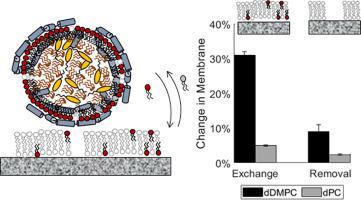Biochimica et Biophysica Acta (BBA) - Molecular and Cell Biology of Lipids ( IF 3.9 ) Pub Date : 2020-07-23 , DOI: 10.1016/j.bbalip.2020.158769 Sarah Waldie 1 , Federica Sebastiani 2 , Kathryn Browning 3 , Selma Maric 4 , Tania K Lind 2 , Nageshwar Yepuri 5 , Tamim A Darwish 5 , Martine Moulin 6 , Gernot Strohmeier 7 , Harald Pichler 8 , Maximilian W A Skoda 9 , Armando Maestro 6 , Michael Haertlein 6 , V Trevor Forsyth 10 , Eva Bengtsson 11 , Martin Malmsten 12 , Marité Cárdenas 2

|
Lipoproteins play a central role in the development of atherosclerosis. High and low-density lipoproteins (HDL and LDL), known as ‘good’ and ‘bad’ cholesterol, respectively, remove and/or deposit lipids into the artery wall. Hence, insight into lipid exchange processes between lipoproteins and cell membranes is of particular importance in understanding the onset and development of cardiovascular disease. In order to elucidate the impact of phospholipid tail saturation and the presence of cholesterol in cell membranes on these processes, neutron reflection was employed in the present investigation to follow lipid exchange with both HDL and LDL against model membranes. Mirroring clinical risk factors for the development of atherosclerosis, lower exchange was observed in the presence of cholesterol, as well as for an unsaturated phospholipid, compared to faster exchange when using a fully saturated phospholipid. These results highlight the importance of membrane composition on the interaction with lipoproteins, chiefly the saturation level of the lipids and presence of cholesterol, and provide novel insight into factors of importance for build-up and reversibility of atherosclerotic plaque. In addition, the correlation between the results and well-established clinical risk factors suggests that the approach taken can be employed also for understanding a broader set of risk factors including, e.g., effects of triglycerides and oxidative stress, as well as local effects of drugs on atherosclerotic plaque formation.
中文翻译:

脂蛋白交换和去除模型膜上脂质的能力取决于脂肪酸饱和度和胆固醇的存在。
脂蛋白在动脉粥样硬化的发展中起着核心作用。高密度和低密度脂蛋白(HDL和LDL)分别被称为“好”和“坏”胆固醇,可将脂质清除和/或沉积到动脉壁中。因此,深入了解脂蛋白和细胞膜之间的脂质交换过程对于理解心血管疾病的发生和发展特别重要。为了阐明磷脂尾巴饱和度和细胞膜中胆固醇的存在对这些过程的影响,在本研究中采用中子反射来跟踪脂质与HDL和LDL对抗模型膜的交换。反映出动脉粥样硬化发展的临床风险因素,在存在胆固醇以及不饱和磷脂的情况下观察到交换降低,与使用完全饱和的磷脂时更快的交换相比。这些结果突出了膜组成对与脂蛋白相互作用的重要性,主要是脂质的饱和水平和胆固醇的存在,并为对动脉粥样硬化斑块的形成和可逆性的重要因素提供了新的见解。此外,结果与公认的临床危险因素之间的相关性表明,所采用的方法也可用于理解更广泛的危险因素,包括甘油三酸酯和氧化应激的作用以及药物的局部作用在动脉粥样硬化斑块形成。主要是脂质的饱和水平和胆固醇的存在,并提供了对于动脉粥样硬化斑块积聚和可逆性重要因素的新颖见解。此外,结果与公认的临床危险因素之间的相关性表明,所采用的方法也可用于理解更广泛的危险因素,包括甘油三酸酯和氧化应激的作用以及药物的局部作用在动脉粥样硬化斑块形成。主要是脂质的饱和水平和胆固醇的存在,并提供了对于动脉粥样硬化斑块积聚和可逆性重要因素的新颖见解。此外,结果与公认的临床危险因素之间的相关性表明,所采用的方法也可用于理解更广泛的危险因素,包括甘油三酸酯和氧化应激的作用以及药物的局部作用在动脉粥样硬化斑块形成。










































 京公网安备 11010802027423号
京公网安备 11010802027423号